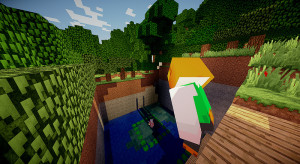
Minecraft has reached critical mass in its popularity (which probably means the kids will move onto something else, but whatever).
You’ve seen the blocky, 8-bit toys at Target. You’ve seen kids totally engrossed in their devices without being on YouTube or Netflix. Minecraft has reached critical mass in its popularity (which probably means the kids will move onto something else, but whatever). Minecraft is a valuable educational tool. Let’s look at the benefits—and why you might want to reconsider limiting their screen time.
Executive reasoning skills
Teachers often refer to a well-known way of organizing how the brain thinks called Bloom’s Taxonomy. Simply put, the higher you go in the taxonomy, the more the brain is engaged and challenged. On the bottom level are skills like remembering and understanding what you’ve learned. On the top level is the ability to create new things with your knowledge.
Minecraft is a platform for creation. Kids need to apply what they’ve learned throughout the game (you need certain minerals to make bricks, for example) to succeed in their goals. In short, it hits the entire taxonomy—something only very skilled teachers can do in a typical lesson.
Academic applications
Speaking of teachers and schools, many classes now employ Minecraft as a learning tool. You might expect the geometry and engineering teachers to be first in line, but the game actually has implications for almost every subject area. Students have been known to create a model of Ancient Rome in history class and blow things up in science class without having to increase the insurance of the school.
Concentration
Do you remember SimCity? You had to keep the citizens happy, grow your infrastructure and economy, all while fending off natural disasters and other challenges. Success in the game took multitasking, anticipation, and focus.
Minecraft activates the same skills in a more powerful and flexible platform. That’s why you see kids turn into device zombies when they’re playing. It’s not to tune out the world; it’s to tune in the world they’re trying to create—and that skill has potent implications for higher education and the working world.
Social skills
Just like most other games these days, Minecraft has the capability to play with others online. The difference is that kids aren’t trying to kill each other in Minecraft. They team up to create communities or succeed against challenges that they might share, like forming a safe environment that protects them from the dangers of the night. There are also vibrant communities for Minecraft enthusiasts on YouTube, wiki pages, and other online forums. Players get on to share their best practices and help each other. It’s a lot better than trying to shoot your friend with a rocket-propelled grenade.
